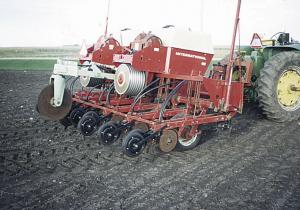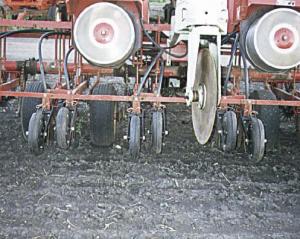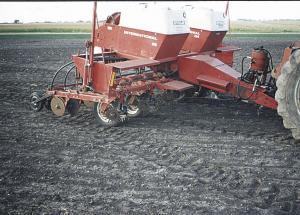Twin Row Ridge Planter For Soybeans
Brad Link, Renville, Minn., wanted the yield increase benefits of higher soybean plant populations, but he couldn't plant them in narrow rows because he farms on ridges. He solved the problem by converting a pair of International Cyclo 6-row air planters into a "twin row" planter that plants two rows 7 in. apart on top of ridges.
"I tried it for the first time last year and had a 1 1/2 bu. per acre yield increase over conventionally-planted beans on ridges, but I think it has the potential for even greater yield increases. The planter cost only about $3,000 to build," says Link.
He paid $450 for a used 6-row planter which was equipped with one seed hopper and blower. He mounted a seed hopper and blower off another Cyclo planter that he al-ready owned and powered both with the planter's original pto-driven hydraulic pump.
He removed the herbicide and insecticide boxes and added six additional row units. The add-on row units mount on separate brackets behind and 7 in. to the side of the original row units. Behind the row units he mounted new 3-in. wide, 13-in. dia. single rib press wheels designed for a Great Plains drill. He mounted new Yetter row cleaning wheels on front of the planter, moving the wheels back on the existing mounting brackets so that each pair of wheels clears a strip wide enough for two rows units. He also mounted a single blade Orthman automatic guidance system on back.
"Some ridge till farmers in my area use grain drills to plant twin row soybeans by plugging up the seed cups. However, I feel my twin row planter places seed much more accurately," says Link. "Also, I didn't have to spend $15,000 or so for a new 15-ft. drill. The automatic guidance system keeps the planter from falling off the ridges. Corn rootballs from the previous year run between the twin rows and aren't a problem. One advantage of twin row soybeans over conventionally drilled beans is that there's 23 in. of space between the twin rows which allows enough air movement to prevent white mold disease. Drilled soybeans do provide a quicker canopy that reduces weed problems. However, on ridges the soil warms up faster in the spring allowing earlier planting.
"I think my twin row planter will also work for planting corn. I plan to try it this spring."
Link made his own brackets for the press wheels that allow him to adjust depth control by simply changing the position of a couple of cotter pins. "I used grain drill press wheels because they make a groove in the soil where the soil later cracks, allowing the seed to pop up easily," says Link. "I staggered the row units 6 in. apart so that mud and trash won't plug them up."
He paid $1,500 for the guidance system, $40 apiece for the press wheels, and $140 apiece for the row clearing wheels. Contact: FARM SHOW Followup, Brad Link, Rt. 1, Box 116, Renville, Minn. 56284 (ph 612 329-3101).

Click here to download page story appeared in.
Click here to read entire issue
Twin Row Ridge Planter For Soybeans PLANTING EQUIPMENT Planters 20-2-2 Brad Link, Renville, Minn., wanted the yield increase benefits of higher soybean plant populations, but he couldn't plant them in narrow rows because he farms on ridges. He solved the problem by converting a pair of International Cyclo 6-row air planters into a "twin row" planter that plants two rows 7 in. apart on top of ridges.
"I tried it for the first time last year and had a 1 1/2 bu. per acre yield increase over conventionally-planted beans on ridges, but I think it has the potential for even greater yield increases. The planter cost only about $3,000 to build," says Link.
He paid $450 for a used 6-row planter which was equipped with one seed hopper and blower. He mounted a seed hopper and blower off another Cyclo planter that he al-ready owned and powered both with the planter's original pto-driven hydraulic pump.
He removed the herbicide and insecticide boxes and added six additional row units. The add-on row units mount on separate brackets behind and 7 in. to the side of the original row units. Behind the row units he mounted new 3-in. wide, 13-in. dia. single rib press wheels designed for a Great Plains drill. He mounted new Yetter row cleaning wheels on front of the planter, moving the wheels back on the existing mounting brackets so that each pair of wheels clears a strip wide enough for two rows units. He also mounted a single blade Orthman automatic guidance system on back.
"Some ridge till farmers in my area use grain drills to plant twin row soybeans by plugging up the seed cups. However, I feel my twin row planter places seed much more accurately," says Link. "Also, I didn't have to spend $15,000 or so for a new 15-ft. drill. The automatic guidance system keeps the planter from falling off the ridges. Corn rootballs from the previous year run between the twin rows and aren't a problem. One advantage of twin row soybeans over conventionally drilled beans is that there's 23 in. of space between the twin rows which allows enough air movement to prevent white mold disease. Drilled soybeans do provide a quicker canopy that reduces weed problems. However, on ridges the soil warms up faster in the spring allowing earlier planting.
"I think my twin row planter will also work for planting corn. I plan to try it this spring."
Link made his own brackets for the press wheels that allow him to adjust depth control by simply changing the position of a couple of cotter pins. "I used grain drill press wheels because they make a groove in the soil where the soil later cracks, allowing the seed to pop up easily," says Link. "I staggered the row units 6 in. apart so that mud and trash won't plug them up."
He paid $1,500 for the guidance system, $40 apiece for the press wheels, and $140 apiece for the row clearing wheels. Contact: FARM SHOW Followup, Brad Link, Rt. 1, Box 116, Renville, Minn. 56284 (ph 612 329-3101).
To read the rest of this story, download this issue below or click
here to register with your account number.









